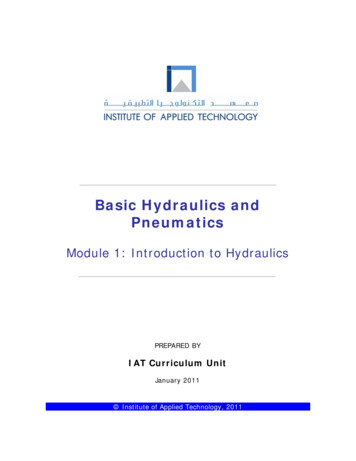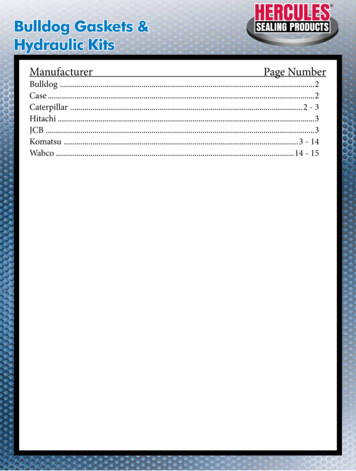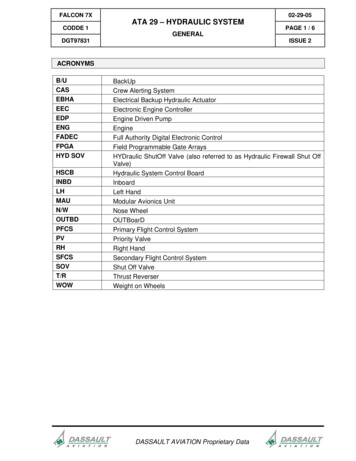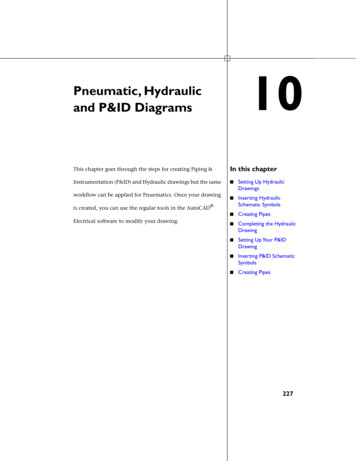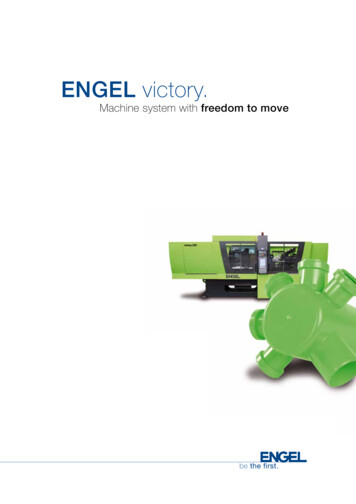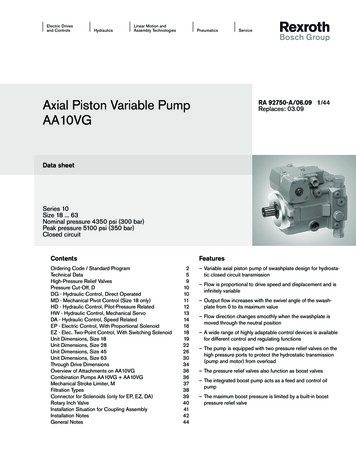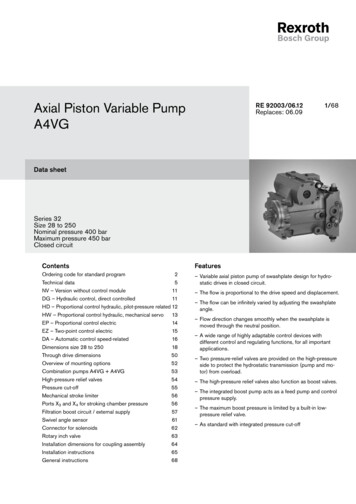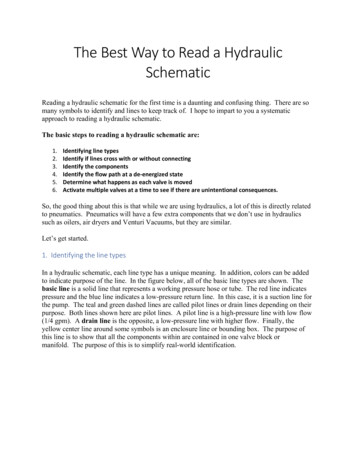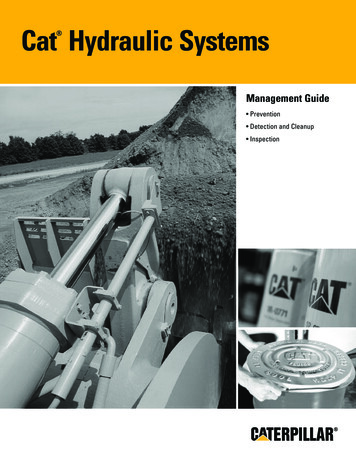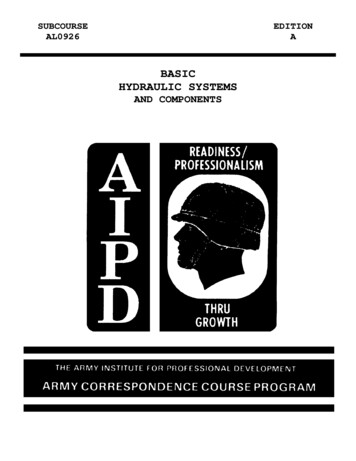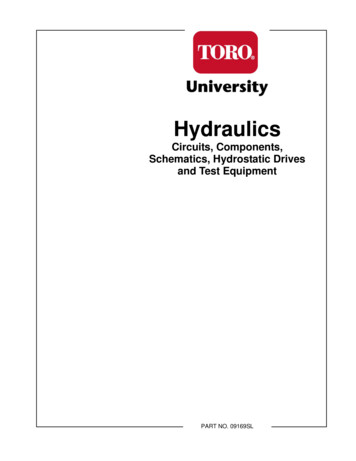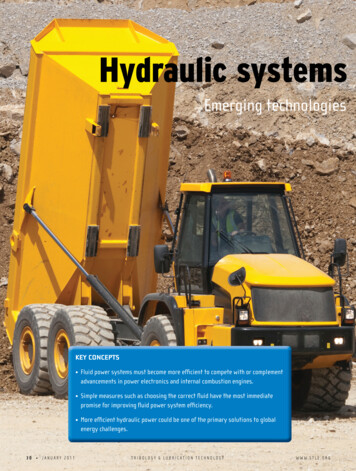
Transcription
Hydraulic systemsEmerging technologiesKEY CONCEPTS Fluid power systems must become more efficient to compete with or complementadvancements in power electronics and internal combustion engines. Simple measures such as choosing the correct fluid have the most immediatepromise for improving fluid power system efficiency. More efficient hydraulic power could be one of the primary solutions to globalenergy challenges.30 JANUARY 2011TRIBOLOGY & LUBRICATION TECHNOLOGYWWW.STLE.ORG
Feature artiCLeJean Van Rensselar / Contributing editortake center stagemake them a cost-effective, energy-conservingalternative to electronics.hydraulic equipment is amazing in its strength andagility. relatively compact, easy to service and sturdy,it produces a significant amount of power for its size.Consider space shuttles. Capable of maintaining a consistent orbit for up to 17 days, they offer the perfect environment for transformative experiments in a number ofscientific disciplines. none of this would be possible without hydraulics—especially the hydraulic components of thesolid rocket boosters.the nasa shuttle’s two solid rocket boosters, located oneither side of the orange external propellant tank, are instrumental during the first two minutes of powered flight, providing about 83% of liftoff propulsion. each powerful booster produces 80% more liftoff thrust than an F-1 jet engine.the booster’s hydraulic power unit operates from t minus28 seconds until the booster’s separation from the orbiterand external tank.there are two self-contained, independent hydraulicpower units on each booster, each consisting of an auxiliarypower unit, fuel supply module, pump, hydraulic reservoirand hydraulic fluid manifold assembly. the auxiliary power units are fueled by hydrazine and generate mechanicalshaft power that drives a hydraulic pump, which produceshydraulic pressure for the booster’s hydraulic system. thegearbox drives the fuel pump, its own lubrication pump andthe hydraulic power unit’s hydraulic pump.the hydraulic pump operates at 3,600 rpm and supplieshydraulic pressure of about 3,050 psi. each shuttle’s hydraulic systems are reusable for 20 missions.For their size, hydraulic systems are among the mostpowerful in the world, yet compared to mainstream alternatives they are inefficient and technologically poor. the goodnews is that researchers and the hydraulic industry are working on important breakthroughs.the impetus for change is partly a challenge from cutting-edge electromechanical alternatives but also a responseWWW.STLE.ORGto a long-overdue need for better fluid power technology.Paul michael is a research chemist at the milwaukeeschool of engineering’s (msoe) Fluid Power institute. hehas been formulating and testing hydraulic fluids for morethan 30 years and is current Chairman of the national FluidPower association (nFPa) Fluids Committee.“there are several reasons for the current focus on improving hydraulic system efficiency,” michael said. “energyGM’S LS2 Fluid Selection StandardSTLE-member Don Smolenski was instrumental in developingGeneral Motors’ LS2 Fluid Selection Standard, which hasa purpose of—among other things—ensuring that userschoose hydraulic fluids with the best properties for theapplication. Some of the standard’s specific goals are to: Improve equipment reliability and prolong life. Improve the likelihood of using the proper fluids inplant applications. Reduce the number of unnecessary fluids in theplants. Provide plants with a list of approved lubricants. Support fluid selection and application bestpractices.Developers believe that the standard will reduce usage,repairs, spill and leak remediation, worker accidents anddisposal costs. A detailed cost analysis estimated that,implementing the standard, a machine using 100 gallonsof hydraulic fluid a month could reasonably produce asavings upward of 1,440 a month.TRIBOLOGY & LUBRICATION TECHNOLOGYJANUARY 2011 31
Without concerted improvements, hydraulics could become anobsolete power source within 30 years.expenditures in the u.s. haveincreased by 25% in the lastdecade. high energy costs andthe down economy have motivated businesses to find waysto reduce consumption. in addition, it is clear that at leastsome of the interest is driven bya desire to reduce carbon emissions.”THE SITUATIONalthough the threat of emerging electromechanical solutionsinto power ranges high enoughto compete with hydraulicswill be a slow process, expertsagree that the hydraulic fluidand equipment industries needto get going on new technologynow.Milwaukee School of Engineering (MSoE) students chelsey Jelinski and Brian Blazel examiningFrom a sustainability standthe MSoE dynamometer used for efficiency testing of hydraulic motors.point, fluid power is similar topower electronic and enginetechnology; improved efficiency is required for the developsays. “tribology is definitely going to be a key enabler for thement of smaller machines that consume fewer resources andnext generation of hydraulics.”produce fewer emissions.THE CCEFPsince 1980 there have been more than 15 improvementsthe Center for Compact and efficient Fluid Power (CCein the chemistry of engine oil for diesel and gasoline engines.FP) in minneapolis is working on this. it is a network ofarguably, there have been no significant improvements inresearchers, educators, students and industries focused onhydraulic fluids—they are essentially the same as they were30 years ago1. experts agree that without concerted improvechanging how fluid power technology is researched, appliedments, hydraulics could become an obsolete power sourceand studied. established in June 2006, the CCeFP is a nawithin the next 30 years.tional science Foundation (nsF) engineering research Center. in addition to its nsF grant, the center is supported byseven participating universities—a team of 38 faculty fromthe universities (each with distinguished academic recordsand interests that are unique and cross-disciplinary) is engaged in work on 25 research projects and four test beds.other CCeFP supporters include 52 partner companiesthat provide 750,000 annually in financial support as wellas in-kind donations and expert advice on a project-by-project basis (see page 20 for more on CCEFP).one of the most promising means of improving the ef“the greatest benefit of the CCeFP is that it fosters colficiency of hydraulic equipment is optimization of friction,wear and lubrication at the moving interfaces. stLe-member ashlie martini, assistant professor at Purdue university’sschool of mechanical engineering in West Lafayette, ind.,A promising means of improvingthe efficiency of hydraulicequipment is optimization offriction, wear and lubrication.a straight-grade mineral oil, plus a 1% to 2% zinc-based antiwear additivepackage.132 JANUARY 2011‘Tribology is definitely goingto be a key enabler for the nextgeneration of hydraulics.’TRIBOLOGY & LUBRICATION TECHNOLOGYWWW.STLE.ORG
laboration which is essential when investigating complexresearch problems.” CCeFP faculty member michael said.“also, there is a synergy when industry and academia worktogether. industry provides a reality check for CCeFP facultyresearchers while industry benefits from new technology andskilled college graduates.”CCeFP collaborators are in the process of creating hydraulic and pneumatic technology that is compact, efficientand effective. to that end, research goals include: Dramatically improving the energy efficiency of fluidpower in current applications. Improving the efficiency of transportation by developing fuel-efficient hydraulic hybrid vehicles. Developing mobile human-scale fluid power devices. Making fluid power clean, quiet, safe and easy to use.the CCeFP wants to make a transformative impact (andperhaps create new industries in the process) by reducingpolluting petroleum usage and increasing the ways in whichfluid power improves the quality of life for certain individuals. some CCeFP members set an ambitious goal of 10% average energy savings through the use of new hydraulic fluids.PRIMARY RESEARCH AREASthe nFPa and the national Center for manufacturing sciences (nCms) in ann arbor, mich., created a strategy of research objectives for technical advancements in hydraulics.the six resulting initiatives are:1. increase energy efficiency.2. improve reliability by increasing uptime, eliminatingleaks, reducing maintenance requirements andmaking fluid power safe and easy to use.While it’s only natural to consider system redesign as astarting point for improving the efficiency of hydraulic systems, fine-tuning maintenance protocol and setting standards for fluid selection could actually have a much biggerand more immediate impact on overall efficiency, performance and reliability.“the fluid is the only thing that you can change withoutchanging the hardware to improve efficiency,” explains michael. “this makes optimizing the fluid chemistry an obvious priority.”Let’s examine the four emerging research areas in moredetail.1. Improving system monitoring and maintenance. apump’s efficiency can be reduced by as much as 50% before itreaches the end of its life. that reduced efficiency often goesundetected because of the closed nature of hydraulic systems. among the problems contributing to inefficiency are: Internal leaks Deteriorating piping and valve losses Changes in process requirements and controlstrategies.A pump’s efficiency can bereduced by as much as 50% beforeit reaches the end of its life.regular, comprehensive efficiency tests on all systemcomponents—especially the pump and motor—can quantify energy efficiency, pinpoint areas for improvement andprovide the basis for a cost-benefit analysis of proposed im-3. reduce the size of components and systems whilemaintaining or increasing power output.4. Build smart fluid power components and systems,including self diagnostics and plug-and-play (easy touse) functionality.5. reduce environmental impact by lowering noise andeliminating leaks.6. improve energy storage, recovery and redeploymentcapabilities of fluid power components and systems.those six research areas can be boiled down into the following four:1. improving system monitoring and maintenance2. optimizing fluid selection3. developing new fluids4. redesigning systems & components.34 JANUARY 2011purdue University professor Ashlie Martini and her student JoseGarcia looking at the surface roughness of components inhydraulic motors.TRIBOLOGY & LUBRICATION TECHNOLOGYWWW.STLE.ORG
provements. the potential energy savings can be easily determined by computing the difference between actual systemoperating efficiency and the manufacturer’s original designfor operating efficiency.daily hydraulic system inspections can catch leaks andother hydraulic system problems before they force equipment shutdown.stLe-member don smolenski is an interested end-userand technical fellow at General motors where he has workedfor 31 years. his expertise is in hydraulics, engine oil, metalremoval fluids and anything related to them, including engine test development. he was instrumental in developingGm’s Ls2 maintenance Lubricant standard (see page 30 box).‘If we can save 3%-5% in hydraulicfluids, we can save a lot of moneyoperating our plants.’“a big part of the efficiency equation is keeping the machinery maintained,” he says. “an example is using breathers that aren’t sucking a lot of moist air into the hydraulicsystems.”2. Optimizing fluid selection. “in Gm plants we’vetried to reduce costs in a number of areas with the volumeof chemicals and the volume of energy,” smolenski says. “ifwe can save 3%-5% in hydraulic fluids, we can save a lot ofmoney operating our plants.“one of the issues is that there are elegant ways of measuring energy savings in a lab and then there’s the real world,”he adds. “in order to convince somebody to make the switchto a more efficient fluid, you have to show them that it reallydoes work in the plant.”smolenski believes the best comparative statistic is measuring the difference in the machinery’s kilowatt hours fromone fluid to another.“that’s what you pay for at the end of the day,” he says.“a more efficient system has demonstrated reduced kilowatthours.”the performance of hydraulic pumps and motors is acritical factor in overall hydraulic system reliability. Volumetric (leakage flow) efficiency and hydromechanical (friction) efficiency are the two elements of hydraulic efficiency.the overall efficiency of a hydraulic pump is the product ofboth factors, and both must be considered when selectingviscosity. the Catch-22 is that as fluid viscosity increases,volumetric efficiency tends to increase, while hydromechanical efficiency tends to decrease.“i’ve been really interested in the whole viscosity indexissue,” smolenski says. “new research has shown that viscosity can have an effect but not the effect that we thought.i thought there would be some sort of breakeven point between internal leakage and hydromechanical losses, butWWW.STLE.ORGOil viscosity specificationsThe following specification sets, each with advantagesand disadvantages, are designed to define oil viscosity invarying temperature environments2: ISO 3448 (ASTM D 2422) – ISO VG Classification ASTM D 6080-97 – Fresh & Sheared Oil Viscosities NFPA T2.13.13-2002 – Viscosity Grade SelectionCriteria Swedish Standard SS 15 54 34 – Full FormulationsSpecification Denison HF-O – Fresh & Sheared Oil Viscositiesthere wasn’t. it appears that it’s the heavier fluids that havethe most promise.”at low operating temperatures, particularly at startup,high viscosity negatively affects the mechanical efficiencyof the hydraulic system, resulting in reduced system performance, lubricant starvation and cavitation (air bubbles).high-viscosity fluids can create excessive pressure drops atthe pump inlet, promoting cavitation. this causes metal fatigue, spalling and ultimately diminishes pump longevity.high viscosity in low-temperature conditions can lead toloss of the lubricating barrier and high contact temperatures,which will accelerate wear and may cause the pump to stopworking altogether. Because of this and to prevent cavitation,pump manufacturers specify maximum startup fluid viscosity limits.one of the primary jobs of a hydraulic fluid is providinga lubricating film to reduce wear on dynamic pump components. the effectiveness of that film in a hydraulic pump isdependent on a balance between such factors as viscosity,pressure, sliding speeds and antiwear additive chemistry. astemperatures rise, the film thins and may rupture, creatingdestructive metal-to-metal contact and straining the pump.Wear tends to occur in pump locations that have a bearingon volumetric efficiency. Poor viscosity resulting from hightemperatures creates a cycle of rising temperatures, increasedwear and internal leakage.stLe-member scott Bair, CCeFP member and regents’researcher at Georgia tech’s Center for high Pressure rheology in atlanta, is currently studying elastohydrodynamiclubricating films under extreme contact pressures up to300,000 psi.“the high pressure substantially changes the behavior ofthe liquid in the film,” Bair explains. “We can measure thesechanges in behavior and generate predictions of the filmthickness and friction. mechanical efficiency of fluid powerEnergy Tips – Pumping Systems, Pumping System Tip Sheet #4, Sept. 2005,the u.s. department of energy.2TRIBOLOGY & LUBRICATION TECHNOLOGYJANUARY 2011 35
‘Find a good fluid andkeep it clean, cool anddry—it should be ableto run forever.’“using just the expertise of people inour plants to set specifications, we came tothe conclusion that if a fluid could meet thespecs, it could work in 99.9% of applications in the plant,” smolenski says. “in ourmanufacturing plants, the fewer choicesof fluid the better. Fewer types mean lesschance of misapplication and bigger volume discounts.”smolenski adds that it’s the small changes that have the biggest impact.“it’s a matter of fully utilizing what’s outMSoE professor paul Michael (right) examines a hydraulic motor with graduatethere, not necessarily designing anythingstudents Kelly Burgess (left) and Aaron Kimball.radical,” he says. “i knew i could save money in the plant just by paying attention todetails,andwewereable to save more than 20% on maintesystems can be directly improved by the reduction of frictionnance fluids and cutting fluids by using 50% rerefined oils.at high-pressure contacts.”We couldn’t have done that without a good standard.”smolenski concludes, “the point is that rather than fool“We are just trying to simplify things. there is nothinging around with exotic additives, we might improve efficienmagical;it’s not real high tech. Find a good fluid and keep itcy simply by using an optimized viscosity. We could just startclean, cool and dry—it should be able to run forever.”using a heavier grade of the same product—if the researchdoes bear out.”3. Developing new fluids. “in the vast majority of hyselection of the proper viscosity grade allows equipmentdraulicfluid power applications, the impact of the fluid onto start easily at low temperatures and achieve the oil flowenergy consumption has never been a consideration,” mirates needed for efficient operation at high temperatures.chael says. “Price is often the primary consideration as long asViscosity variations associated with low starting temthe fluid meets viscosity and certain minimum performanceperatures and high operating temperatures contribute tostandards. over the years, engine builders have developedsystem inefficiency and unreliability. at low temperatures,a more sophisticated approach. Lubricants are optimizedduring the design process in order to meet fuel economy,tailpipe emission and vehicle performance objectives. thishigher level of integration, where hydraulic components andfluids are optimized for efficiency and performance, is beingdeveloped through the CCeFP.”in commercial vehicles and mobile fluid power uses,many experts have come to the conclusion that operatingtemperatures and energy efficiency considerations call fortoo much viscosity may result in poor mechanical efficiency,multigrade hydraulic fluids.3 Because of their excellent sheardifficulty starting and wear. as oil temperatures increase,stability, multigrade hydraulic fluids are often recommendedviscosity decreases, resulting in lower volumetric efficiency,for equipment where the operating temperatures vary widely.overheating and wear.in recent years, a variety of laboratory tests and field triat Gm smolenski is working with sae tC-2 and Gm Ls2als have documented efficiency improvements in fluid powerfluid specification development.systems that use certain types of multigrade hydraulic flu“the two sets of specifications are pretty much parallel,”ids.4 these studies have examined the amount of diesel fuelhe says. “We wanted to buy fluids using a performance-based3steven n. herzog and Paul W. michael, Hydraulic Fluid Selection forstandard instead of by name brand. We knew that if someImproved Fuel Economy.thing passed Ls2, it was going to work. having that standard4steven n. herzog and Paul W. michael, Hydraulic Fluid Selection forin place has been very important.”Improved Fuel Economy.‘We were able to save morethan 20% on maintenance fluidsand cutting fluids by using 50%rerefined oils.’36 JANUARY 2011TRIBOLOGY & LUBRICATION TECHNOLOGYWWW.STLE.ORG
‘To convince somebody to make the switch to a more efficient fluid,you have to show them that it really does work in the plant.’that is necessary in heavy equipment vs. the amount of workproduced, and a significant payback in fuel usage and/or productivity has been demonstrated.smolenski is intrigued and encouraged by the prospect ofnew fluid development.“Years ago we tested and found a couple of fluids thatlooked promising, but they had properties that weren’t goodfor a hydraulic system,” he says. “For example, they had anemulsifier in them, and we wanted to shed water. the upside was that we could see there were possibilities.”michael says, “With a positive displacement pump, intheory the flow rate doesn’t change with pressure. in reality, as system pressure increases, the pump internal leakageflow also increases. this results in a reduction in pump volumetric efficiency. increasing the viscosity of the fluid canmitigate pump internal leakage losses. since viscosity indeximprovers increase viscosity, volumetric efficiency can be enhanced using shear stable multigrade oils.”on face value, it’s logical to conclude that improving fluidpower efficiency could be as simple as switching to a higherviscosity fluid. this may be the case in applications wheretemperatures are stable and higher volumetric efficiencycan translate into increased productivity. But from a moreconsidered standpoint, system architecture, duty cycle andoperating temperatures need to be considered. While thepump may be the source of power in a hydraulic system, itis important to recognize that every element in a circuit canimpact efficiency.msoe researchers are studying how fluid properties effect hydraulic motors. “We have identified fluids that canincrease the efficiencies of hydraulic motors by as much as18%,” michael explains.‘We have identified fluidsthat can increase the efficienciesof hydraulic motors by asmuch as 18%.’Collaborative research between afton Chemical Corp. andmsoe has shown that hydraulic motor efficiency dependsupon the motor type, pressure and fluid used. Correlationsbetween a fluid’s boundary and mixed lubrication frictionalproperties have been found and the relative effect of theseproperties depends upon motor type and pressure. thesestudies indicate that properties other than viscosity can havea profound effect on low-speed hydraulic motor efficiency.rohmax oil additives, for example, has developed andproduced shear stable polymers that work well for hydraulic38 JANUARY 2011applications. these polymers make hydraulic fluid breakdown-resistant under the high-pressure conditions that arepresent in most industrial equipment.“the viscosity aspect is the most interesting thing tome,” smolenski says. “But a question that nags at me is howour pump sizes play into this. Can you save 5%-10% justby dropping the pump size down by 20% if the system wasoverdesigned?”michael agrees that smaller is the way to go. he explainsthat, to that end, there are only two ways that a smaller pumpcan do the same job—raise the system pressure or increaseefficiency. this is because the power output of a pump is theproduct of flow rate (pump size) and pressure. For this reason, researchers at the CCeFP are working on projects thatreduce size and improve efficiency.4. Redesigning systems and components. the CCeFP vision has been continuously modified and refined overthree years. right now, it is working with two fundamentalobservations:1. it is not well known how fluid power scales with sizeas measured by weight or power.2. the competitive advantage of fluid power is greatestin mobile applications.Working with those observations, the four CCeFP testbeds address the following four areas:1. Mobile Heavy Equipment (50 kW-500 kW): specificresearch on an excavator.2. Highway Vehicles (10 kW-100 kW): specificresearch on a hydraulic hybrid passenger vehicle.3. Mobile Human Scale Equipment (100W-1kW):specific research on a compact rescue robot.4. Human Assist Devices (10W-100W): specificresearch on orthosis (devices that support or correcthuman musculoskeletal deformities and/or abnormalities).spanning four orders of magnitudes of power and weight,the test beds represent mobile applications where experts believe that fluid power is the best solution. in addition, theyencompass current and future fluid power applications, influence adjacent applications and have the potential to ameliorate important human needs.5developed by a team led by professor Perry Li at the university of minnesota.6explored by a team led by John Lumkes at Purdue university.TRIBOLOGY & LUBRICATION TECHNOLOGYWWW.STLE.ORG
one specific CCeFP goal is to develop high-speed valvesthat can toggle quickly with fairly high flow rates and smallpressure drops (practical high-speed valves).there are promising research projects for new valve designs. one at the university of minnesota is a pulse-widthmodulated rotary valve that will eliminate acceleration anddeceleration and allow for switching at significantly fasterspeeds.5another is a high-speed poppet valve at Purdue university’s maha Fluid Power research Center.6 the Purdue teamhas developed a prototype that isa pressure-balanced, three-way,two-position poppet sealing valve.While this valve development isimportant, the challenge is to usethe valves in actual hydraulic systems, something the Purdue teamis working on.a goal of the poppet valve project is to optimize valve modelingand develop equation structuresthat focus on how fluid, mechanical and electromagnetic mechanisms interact in high-speed on/offvalves.Purdue is conducting hydraulic systems research in two majorareas: developing energy-savinghydraulic drive systems and developing and optimizing pumps andmotors. Current projects include:what physically influences the energy dissipation in pumpsand motors with the goal of developing appropriate modelsand then describing those influencers and their effects.to that end, they are developing custom, in-house software tools and using them to predict the conditions andload-carrying ability of the flow through sealing and bearinggaps considering non-isothermal gap flow, the micro-motionof parts and fluid-structure interaction.the ultimate goal is to predict energy dissipation and tofind new methods for pump and motor design. the result of Investigating new circuitsolutions Creating appropriatemathematical models andsimulations Advancing actuator anddrive line control conceptsRelieve Hydraulic Pressure, Online Developing methods foronline prognostics andcondition monitoring foragricultural and othermobile machines.Introducing HydraulicFacts.com: the world’s firsthydraulically driven website designed to relieve the pressuresof your job through the transmission of hydraulic fluid andsystem knowledge. Visit today for news and education onhydraulic trends delivered with fluidity and precision, 24/7.When the Purdue team recently analyzed a 5-ton miniexcavatorduring a typical trenching cycle,they discovered that only about15% of the engine energy was expended in useful work, while morethan 40% of the engine energy wasdissipated in valve losses.the team is working to discoverWWW.STLE.ORGRegister today for updates onHydraulicFacts.comThe Authority On Hydraulic Fluids & Systemswww.lubrizol.com 2010 All rights reserved.TRIBOLOGY & LUBRICATION TECHNOLOGYJANUARY 2011 39
U.S. DOE monitoring andmaintenance guidelinesThe U.S. Department of Energy has the followingrecommendations for testing, identifying andmaintaining hydraulic system efficiency: Survey the priority pumps and conductefficiency tests. Identify misapplied, oversized pumps withoperating points below the manufacturer’spump curve (if available) and estimateenergy savings of restoring system to itsoriginal efficiency. Identify pumps with flow rates of 30% ormore than the BEP flow rates or withsystem imbalances greater than 20%(check system pressures and cycle times). Determine the cost-effectiveness ofproposed improvements.this research should be: Improved efficiency of pumps and motors Increased power density Decreased design time, with more accurate results.Within the CCeFP, energy efficiency is viewed as a capstone goal enabled by foundational improvements in valves,pumps, motors and fluids. the organization is currentlytrying to create more compact fluid power systems by reducing size and weight. this will enable the development ofhydraulic-powered human-scale assistive devices and wearable tools for home and industrial use.research at Purdue university, sponsored by the nsF andthe nFPa, is centered on a method for reducing the draw ofmobile hydraulic system power. Basically, the method replaces traditional flow control valves with variable displacementpumps. instead of connecting multiple hydraulic actuatorsin parallel to a single pump, each actuator is controlled bysmaller, individual pumps.this approach promises lower power losses and the ability to recover energy while performing certain tasks. the sys7this research is currently being conducted by graduate students Chris Williamson, Josh Zimmerman and edward hughes at Purdue university as partof the CCeFP.40 JANUARY 2011tem also can adjust engine speed and pump displacement tokeep the engine operating close to peak efficiency. these developments, once implemented, could significantly increasefuel efficiency.7DIGITAL TECHNOLOGYPurdue’s valve research and test implementation is part ofa movement toward digital hydraulics in high-speed applications where existing technology is too slow and there isan opportunity to appreciably improve system efficiencies.these high-speed valves could be important components ofmore efficient hydraulic systems.in addition, digital technology has the potential to spurnew developments in fluid power that could include motor,pump and valve innovations. digital valves also could significantly reduce or eliminate leakage and boost performanceand efficiency.While research is promising, many new technologies stillneed to prove their worth in real-world applications.“i have had some discussion with Paul michael tryingto plant-trial these things as they come forward,” smolenski says, “but that requires a lot of coordination at the plantlevel, especially when most plants are already short-handed.”IN THE END so who stands to profit from more efficient hydraulic systems?“end-users will benefit first because we will see cost savings immediately,” smolenski says. “i think fluid supplierswill have an opportunity to create a grea
the hydraulic pump operates at 3,600 rpm and supplies hydraulic pressure of about 3,050 psi. each shuttle’s hydrau-lic systems are reusable for 20 missions. For their size, hydraulic systems are among the most powerful in the world, yet compared to mainstream alterna-tive
